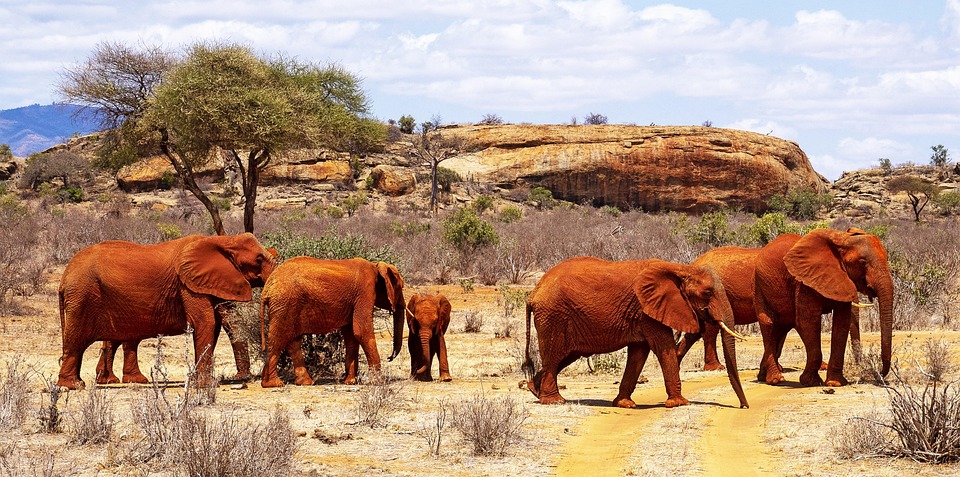What happens when Africa's most intelligent giants discover they can become living masterpieces using nothing but the earth beneath their feet? Welcome to one of the natural world's most spectacular art projects: the red elephants of Tsavo, where every creature has transformed into a walking sculpture painted in shades of rust, copper, and fire.
These aren't genetic mutations or some photographer's Photoshop; they're real African elephants who have mastered the ancient art of environmental camouflage and protection through their extraordinary relationship with Tsavo's iron-rich red soil.
But this remarkable transformation reveals something far deeper than aesthetic beauty; it's a masterclass in adaptation, intelligence, and survival that challenges our fundamental understanding of how wildlife interacts with their environment.
Each red elephant tells a story of evolutionary brilliance, where practical necessity has created some of the most visually stunning elephants on earth, turning Tsavo into nature's own living art gallery, where every elephant encounter feels like a work of art in motion.
The Science Behind the Red Jumbos
The red elephants of Tsavo aren't a separate species or genetic variant. Tsavo’s magnificent creatures acquire their distinctive coloration through constant interaction with Tsavo's unique geological composition. The region's soil, classified as ferralsol, contains exceptionally high levels of iron oxide, giving the earth its characteristic reddish-orange hue.
This ancient, highly weathered soil, formed over millions of years in Tsavo's tropical climate creates the perfect medium for the elephants' daily dust-bathing rituals. As elephants spray themselves with this iron-rich laterite soil using their trunks, the fine particles adhere to their skin, creating a protective coating that transforms their natural gray hide into the iconic red coloration that has made them world-famous.
The Essential Behavior of Dust Bathing
Dust bathing serves multiple critical functions beyond creating Tsavo's signature red elephants. This essential behavior acts as:
Natural Sun Protection
The iron-rich dust creates an effective sunscreen, protecting elephants' sensitive skin from Africa's intense UV radiation. This is particularly crucial in Tsavo's semi-arid environment, where shade is limited.
Parasite Control
The abrasive action of dust particles helps remove external parasites and provides ongoing protection against insects. The coating creates a barrier that deters mosquitoes, flies, and other biting insects.
Skin Health Maintenance
The mechanical action helps remove dead skin cells and maintains overall skin health, similar to exfoliation in other species.
Tsavo's Geological Foundation
The geological story of Tsavo begins millions of years ago. The region's unique basement rock formations, some dating back 570 to 4,550 million years, have been exposed through tectonic activity and erosion. This ancient foundation, combined with volcanic activity from the nearby Chyulu Hills, has created the iron-rich soils that define the landscape.
Interestingly, these same geological conditions that create the red elephants also contributed to Tsavo's designation as a protected area. The poor fertility of the iron-rich soils made the region unsuitable for agriculture, leading to its establishment as a wildlife reserve in 1949, a serendipitous preservation that now protects over 42,000 square kilometers of critical elephant habitat.
A Global Perspective on Elephant Coloration
Tsavo's red elephants are part of a fascinating global phenomenon. Not just in Tsavo - elephants across Africa display different colorations based on their local environments:
Tsavo's red elephants: Iron oxide-rich soil creates the distinctive reddish-brown coloration
Etosha's white elephants: Salt pan deposits in Namibia create ghostly white appearances
Maasai Mara's gray elephants: Black cotton soil produces darker gray coloration
This natural variation demonstrates elephants' remarkable ability to adapt their protective behaviors to local environmental conditions.
The Broader Ecological Significance
Red elephants serve as keystone species in the Tsavo ecosystem. Their daily activities create:
Habitat modification: Clearing vegetation and creating pathways for other species
Seed dispersal: Spreading plant species across vast distances through their dung
Water access: Digging wells that benefit numerous other animals
Nutrient cycling: Fertilizing soils and maintaining ecosystem productivity
Research and Scientific Understanding
Recent scientific advances have deepened our understanding of elephant behavior and ecology. Studies have revealed:
Complex social structures: Matriarchal wisdom crucial for herd survival
Advanced communication: Possible use of individual "names" among elephants
Remarkable intelligence: Problem-solving abilities and emotional complexity
Ecosystem engineering: Profound landscape-shaping capabilities
The Future of Tsavo's Red Giants
The red elephants of Tsavo represent more than a unique natural phenomenon; they embody the resilience of African wildlife and the importance of conservation. Organizations like Tsavo Trust continue working with the Kenya Wildlife Service and local communities to ensure these magnificent creatures thrive.
Current conservation strategies include:
Technology integration: GPS collaring and EarthRanger tracking systems
Community engagement: Local employment and education programs
Anti-poaching operations: Aerial and ground-based protection units
Habitat preservation: Maintaining critical elephant corridors and water sources
Witnessing the Red Elephants
For wildlife enthusiasts, encountering Tsavo's red elephants offers an unparalleled safari experience. The sight of these crimson giants against Tsavo's red earth landscape creates one of Africa's most iconic wildlife spectacles. Their unique coloration, born from millions of years of geological processes and evolutionary adaptation, serves as a powerful reminder of nature's ingenuity and the delicate balance that sustains our planet's biodiversity.
The red elephants of Tsavo stand as living symbols of successful conservation, geological wonder, and the enduring magic of African wildlife. Their continued protection ensures that future generations will witness this extraordinary phenomenon where ancient geology, animal behavior, and conservation science converge to create one of nature's most remarkable displays.
